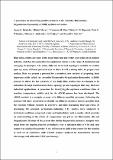Files in this item
A procedure for identifying possible products in the Assembly-Disassembly-Organisation-Reassembly (ADOR) synthesis of zeolites
Item metadata
| dc.contributor.author | Henkelis, Susan E. | |
| dc.contributor.author | Mazur, Michal | |
| dc.contributor.author | Rice, Cameron M. | |
| dc.contributor.author | Bignami, Giulia P. M. | |
| dc.contributor.author | Wheatley, Paul S. | |
| dc.contributor.author | Ashbrook, Sharon E. | |
| dc.contributor.author | Čejka, Jiří | |
| dc.contributor.author | Morris, Russell E. | |
| dc.date.accessioned | 2019-07-24T23:41:00Z | |
| dc.date.available | 2019-07-24T23:41:00Z | |
| dc.date.issued | 2019-01-25 | |
| dc.identifier | 256551179 | |
| dc.identifier | 6311aefd-8d4f-4516-b2b5-89adbcd92133 | |
| dc.identifier | 85060592984 | |
| dc.identifier | 000459890700005 | |
| dc.identifier.citation | Henkelis , S E , Mazur , M , Rice , C M , Bignami , G P M , Wheatley , P S , Ashbrook , S E , Čejka , J & Morris , R E 2019 , ' A procedure for identifying possible products in the Assembly-Disassembly-Organisation-Reassembly (ADOR) synthesis of zeolites ' , Nature Protocols . https://doi.org/10.1038/s41596-018-0114-6 | en |
| dc.identifier.issn | 1754-2189 | |
| dc.identifier.other | ORCID: /0000-0002-4538-6782/work/56638895 | |
| dc.identifier.other | ORCID: /0000-0001-7809-0315/work/61622049 | |
| dc.identifier.uri | https://hdl.handle.net/10023/18159 | |
| dc.description | The authors would like to thank the EPSRC (grants: EP/K025112/1; EP/K005499/1; EP/K503162/1; EP/N509759/1) for funding opportunities. R.E.M., J.C. and M.M. would like to acknowledge OP VVV "Excellent Research Teams", project No. CZ.02.1.01/0.0/0.0/15_003/0000417 - CUCAM. S.E.A. would like to thank the Royal Society and the Wolfson Foundation for a merit award. J.C. acknowledges the Czech Science Foundation (P106/12/G015). | en |
| dc.description.abstract | High-silica zeolites, some of the most important and widely used catalysts in industry, have potential for application across a wide range of traditional and emerging technologies. The many structural topologies of zeolites have a variety of potential uses, so a strong drive to create new zeolites exists. Here, we present a protocol, the assembly–disassembly–organization–reassembly (ADOR) process, for a relatively new method of preparing these important solids. It allows the synthesis of new high-silica zeolites (Si/Al >1,000), whose synthesis is considered infeasible with traditional (solvothermal) methods, offering new topologies that may find novel applications. We show how to identify the optimal conditions (e.g., duration of reaction, temperature, acidity) for ADOR, which is a complex process with different possible outcomes. Following the protocol will allow researchers to identify the different products that are possible from a reaction without recourse to repetitive and time-consuming trial and error. In developing the protocol, germanium-containing UTL zeolites were subjected to hydrolysis conditions using both water and hydrochloric acid as media, which provides an understanding of the effects of temperature and pH on the disassembly (D) and organization (O) steps of the process that define the potential products. Samples were taken from the ongoing reaction periodically over a minimum of 8 h, and each sample was analyzed using powder X-ray diffraction to yield a time course for the reaction at each set of conditions; selected samples were analyzed using transmission electron microscopy and solid-state NMR spectroscopy. | |
| dc.format.extent | 14 | |
| dc.format.extent | 724143 | |
| dc.language.iso | eng | |
| dc.relation.ispartof | Nature Protocols | en |
| dc.subject | QD Chemistry | en |
| dc.subject | DAS | en |
| dc.subject.lcc | QD | en |
| dc.title | A procedure for identifying possible products in the Assembly-Disassembly-Organisation-Reassembly (ADOR) synthesis of zeolites | en |
| dc.type | Journal article | en |
| dc.contributor.sponsor | EPSRC | en |
| dc.contributor.sponsor | EPSRC | en |
| dc.contributor.sponsor | The Royal Society | en |
| dc.contributor.institution | University of St Andrews. School of Chemistry | en |
| dc.contributor.institution | University of St Andrews. EaSTCHEM | en |
| dc.identifier.doi | 10.1038/s41596-018-0114-6 | |
| dc.description.status | Peer reviewed | en |
| dc.date.embargoedUntil | 2019-07-25 | |
| dc.identifier.grantnumber | EP/K025112/1 | en |
| dc.identifier.grantnumber | EP/K005499/1 | en |
| dc.identifier.grantnumber | WM150021 | en |
This item appears in the following Collection(s)
Items in the St Andrews Research Repository are protected by copyright, with all rights reserved, unless otherwise indicated.

